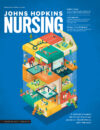Building plans make room for the future
story steve st. angelo | illustrations andrea de santisIn academia, we say that learning can happen anywhere, but we never really expected to see it in back stairwells, mini-kitchens, printer rooms, or on the floors of long hallways. But indeed this is where we often find our students studying and collaborating. While we’re heartened by their ingenuity and focus, this is not the ideal learning environment for a top-ranked school that attracts the best and the brightest.
A need for more space and even bigger thinking was clear long before the Johns Hopkins School of Nursing could take the leap.
The student body has expanded from approximately 500 individuals at the 1998 opening of the Pinkard Building to 1,200. The school needs to keep recruiting the students and faculty required to address the critical nursing workforce shortage. It seeks to become an even stronger magnet for global scholarship and cooperation. And, most principally, the school lacks the collaborative and research spaces that contribute to graduate-level education. Designed mainly as an undergraduate learning environment, Pinkard is underprepared for that role, its beauty notwithstanding.So in Autumn 2018, shovels will once again break ground in East Baltimore as the school embarks on a roughly $45 million project featuring a five-story, 41,000-square-foot addition and the renovation and reimagining of 24,810 square feet within the 93,290-square-foot Pinkard Building. Over the next several pages are architects’ renderings of what the finished project could look like and more information on how the project will transform the school into a hub for research, a magnet for global collaboration, an equal partner on the East Baltimore medical campus, and a beacon to the best and brightest students and faculty in the world.In addition to students, the existing space demands imagination and flexibility from teachers, clinicians, visiting scholars, and staff. To stay competitive, and to fulfill the promise to the next generations of Hopkins Nursing students, would require a significant reimagining of the type and size of spaces. And without a doubt, the building needed to grow, a lot.” We promise—and deliver—the best graduate education available. But we find ourselves making quick fixes so that people don’t feel the squeeze. This plan is a more permanent solution.”
— David Newton “You get to a point where you start thinking about your competitive edge,” explains David Newton, associate dean for finance and administration, who has taken a lead role on the project. “We are one of the top graduate nursing schools in the world today, and that’s not an accident. We promise—and deliver—the best graduate education available. But we find ourselves making quick fixes so that people don’t feel the squeeze. This plan is a more permanent solution.”Graduate students learn differently, and are taught differently. They require and insist upon better access to faculty—for mentoring and for collaboration. To continue recruiting the best and brightest, the School of Nursing needs a building that can catch the eye of potential grad students, then wow them with its educational amenities. And to attract more of the globe’s thought leaders for study, research, and partnership, there must be contemplative, flexible space and ready technology.
Newton believes the structure envisioned by architects from Hord Coplan Macht and William Rawn Associates, which eliminates the SON House and conjoins five floors worth of space to the Pinkard Building, more than meets that lofty goal. “The phrase ‘student-centric’ has been at the top of the drawing board since the beginning of this process,” he says, adding that the addition would create “a ‘Welcome’ sign to the world.”
Renderings include glass surfaces and entrance spaces that offer a glimpse of all that is going on within the school to the community of nursing, to colleagues and collaborators on the East Baltimore campus, and to the neighborhood itself. Internally, the building features spaces for collaboration and contemplation, creates synergies between clinical and research faculty, and provides ample space for student and faculty collaboration on health care solutions for the future.
A few particular features:
Student Hub where extracurricular activities and out-of-classroom learning occurs and where seeds of collaboration are planted.
Study Cube where students can maximize their learning potential alone and in groups.
Think Tank an interprofessional hub to house research faculty and staff.
Conference Center that could bring perhaps 10,000 visitors to the school each year for innovation and collaboration – hord cOplan macht + william rawn associates. It wasn’t only physical constraints that the architects sought to relieve in their initial plans but emotional barriers as well. For instance, architect Cliff Gayley of William Rawn Associates pointed to student complaints about feeling out of their element anywhere above the third floor of Pinkard. (Most faculty offices are on the fourth floor, with the dean’s staff and Development and Alumni Relations inhabiting the fifth.) New plans call for a far more mixed-use structure with student-centric features from the street level up, the Center for Research Excellence on the fifth floor, “right-sized” classrooms throughout, and a genuine flow of people and information -hord cOplan macht + william rawn associates. Besides its obvious and immediate impact on the Johns Hopkins School of Nursing, the building project will have a positive impact for Maryland, for Baltimore, for research, and for nursing care across the nation and the world:
The reputation of the No. 1 master of science in nursing program (U.S. News & World Report 2017 rankings) and the No. 2 nursing school in the world (QS World University 2018 rankings) attracts world-class talent to the state as well as millions of dollars in annual research funding. These factors will only be enhanced.
The project supports the state’s growing reputation as a leader in health care research and practice.
The School of Nursing produces some 250 master’s-prepared nurses and NPs annually.
The school could produce 30 percent more graduates annually by 2021.
Hundreds of construction jobs will be created during an 18-month building phase (expected to end in winter 2020).
Through HopkinsLocal, there will be a minimum of 20 percent participation by minority- and women-owned firms and 8 percent participation by business enterprises with offices in Baltimore city.
“We are determined to keep putting the best students, researchers, faculty, alumni, and staff into the right facility,” says Dean Patricia M. Davidson, PhD, MEd, RN, FAAN. “This is a bold commitment to the future of health care and nursing education. We couldn’t wait any longer, and we can’t wait for the day we cut the ribbon.”‘One Flexible Environment’. It was a powerful snapshot. On a walk-through of the Pinkard Building, Paul Lund, principal of the architecture firm Hord Coplan Macht, was struck by the buzz and the ingenuity of students in creating study spaces, as well as the lengths to which they needed to go. When he spied a young woman seeking a quiet zone in a back stairwell, he had an inspiration.
“Clearly, the building has served the School of Nursing well,” Lund says of his impressions of Pinkard. “It is a nice building, but when you enter you are struck by how much activity there is and how little gathering space there is.”
That can happen when you become the top school in the nation and the student body grows, then changes radically. “The building was designed for undergraduate education,” Lund explains. “Over time, the changes in pedagogy as the school shifted to an all-graduate format have required more student-centric learning spaces.” He adds, “The school is No. 1 in research, but try to find evidence of that in the building.”
Large lecture halls, now three quarters empty at times, had become outmoded. Architect Cliff Gayley of William Rawn Associates says a separation from faculty and research opportunities—actual as well as perceived—was clear from interactions with students. A five-story layout had come to function as very separate zones of activity. And the stairwells weren’t built as learning modules.
Lund worked with Gayley to address the needs of modern nursing education, collaboration, and research with “right-sized classrooms,” a student hub, a “study cube for collaboration beyond the classroom,” and the Think Tank—a research center—expanding Pinkard by about 41,000 square feet, and the possibilities of education and research well into the 21st century.
One of Dean Patricia Davidson’s goals in the construction and remodeling of Pinkard is to further establish the School of Nursing’s “presence.” Internally, this means seamless clinical, research, and learning as well as a sense of community—“one flexible environment.” Externally, this means a building that can stand shoulder to shoulder with the Bloomberg School of Public Health and Johns Hopkins Hospital while projecting an openness to the East Baltimore community they all serve.
Gayley and Lund had plenty to go on, including one indelible image of what didn’t work.
— Steve St. Angelo
‘Meet Me at Pinkard’
There’s a space with your name on it at the Johns Hopkins School of Nursing.
Or there could be soon enough. Unnamed areas of the School of Nursing expansion project include everything from a conference center and classrooms to the commons and the courtyard. These are the areas whose names will become shorthand and compass points for students into the future.
And naming rights are but one way to contribute to the future of nursing education and the profession itself as we transform the Pinkard Building for the opportunities and challenges of the 21st century. Collaboration is being built into the structure, including the relationships with our supporters at every level of giving.
A brick campaign, currently slated as a wall of the courtyard, will allow donors to contribute at smaller levels and be a part of this historic building transformation. More details will be announced as the design details are formalized.
Money for the $45 million project will come in part from a blend of operating cash and debt, the latter of which shrinks of course as more supporters join the effort. A big boost has already come from benefactors including the France-Merrick and Blaustein foundations. The rest will come through continued fundraising as we begin to show the progress and impact we are making in East Baltimore and beyond.
To learn more about the Johns Hopkins School of Nursing construction project, its value to students and the community, and how you can be a part of building the future, visit building4jhunursing.org.
To learn more about naming rights and giving opportunities or to make a contribution, please contact the Office of Development and Alumni Relations at 410-955-4284 or by email at [email protected].

